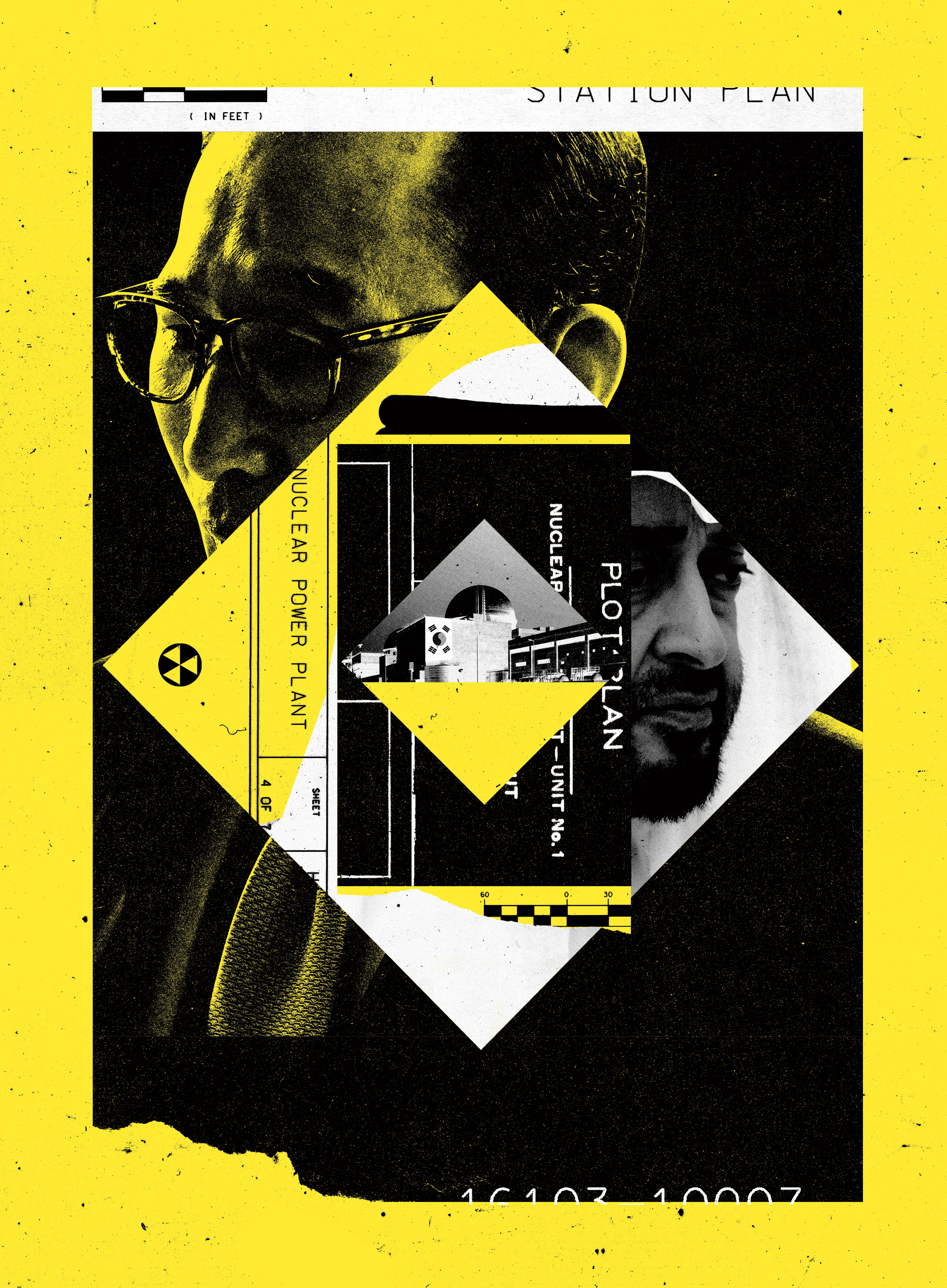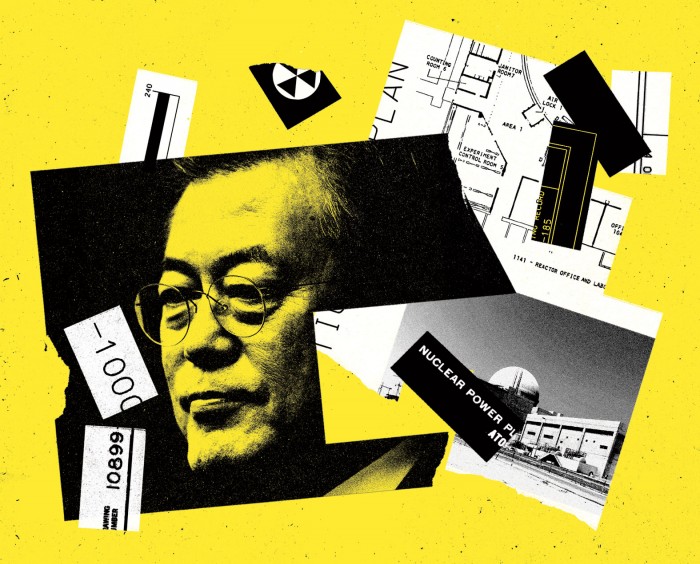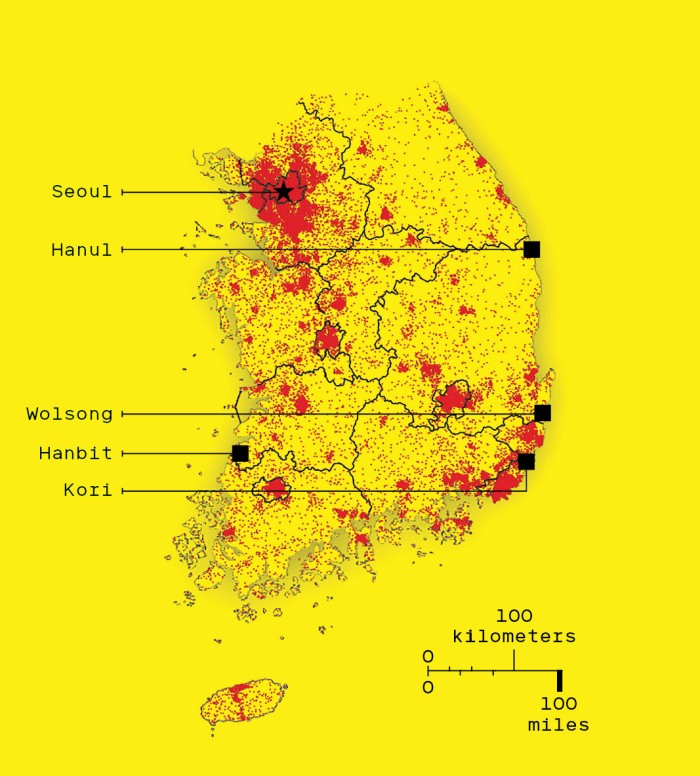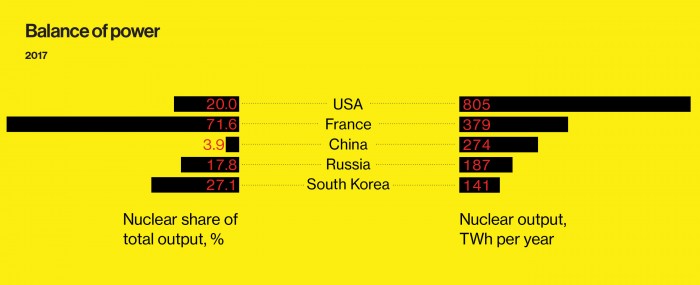How greed and corruption blew up South Korea’s nuclear industry
Seoul had a solution to the world’s energy problems. Then everything went wrong.

Three days after a tsunami battered the Fukushima Daiichi nuclear power plant in Japan, South Korean president Lee Myung-bak was celebrating. It was March 14, 2011, and he was in the United Arab Emirates, on a dusty, featureless stretch of desert 30 miles (48 kilometers) from the nearest village. Lee was presiding over a groundbreaking ceremony for a construction project that the two countries said marked the start of a “hundred-year friendship.” A retinue of dark-suited South Korean officials and Emirati dignitaries in flowing white thawbs toured the site. Then Lee and the UAE’s Crown Prince Mohammed bin Zayed smiled and posed for photographs on a red carpet.
Two years earlier, a South Korean consortium had won an $18.6 billion contract to build four nuclear reactors on the ground where Lee now stood—at the time, the single biggest reactor deal in history. The plant—named Barakah, after the Arabic word for a divine blessing—was a personal triumph for Lee, who had reportedly swung the deal with a desperate 11th-hour phone call to bin Zayed, and a victory for his country, whose Korea Electric Power Corporation, Kepco, had led the bid and won out against more experienced French competition. It made for a great underdog story. A small, resource poor nation that relied heavily on imported energy, South Korea had kick-started its nuclear program in the 1970s by buying reactors on turnkey contracts from Canada, France, and the United States. But Kepco and its nuclear affiliate, KHNP, quickly developed their own model based on an American design. The first homegrown reactor was operational by 1995, and more soon followed. Eventually South Korea, which is roughly the size of Indiana, became the most reactor-dense country in the world, with 23 reactors providing about 30% of its total electricity generation. The Emiratis had been impressed.
More was at stake in the UAE than just South Korea’s national pride, however. What the country was doing could help solve the climate crisis. While renewable-energy production has grown dramatically, many scientists, engineers, and environmental activists believe a nuclear power system is the only truly scalable alternative to fossil fuels. Yet over the years the high capital costs, uncertain profits, and safety concerns associated with nuclear power have discouraged investors and led governments back to cheaper, dirtier fuel sources like coal and gas.
The French state-owned company Areva, for example, had a project in Finland that was already billions of dollars over budget and years behind schedule. The US’s $6.8 billion Watts Bar Unit 1 reactor in Tennessee had taken 23 years to complete, and cost more than 18 times its original $370 million price tag. Areva had bid for the Barakah project, but its $36 billion proposal was reportedly almost twice as high as Kepco’s. The Korean bid rekindled the hope that nuclear could be clean, safe, and cheap enough to replace fossil fuels.

How did Kepco manage it? Lee Hee-yong, a former Kepco executive who had led the bid, told me the key was repetition—building to the same template over and over, rather than designing customized plants each time as was typical. This increased expertise and efficiency, and the result was lower prices. “Prior to the UAE deal, we had been continuously building reactors for the past 30 or 40 years,” he told me in the office of his two-person boutique energy consultancy in Seoul. “The fact that we maintained a strong supply chain and network of specialized workers was key to keeping costs low.”
South Korea, which is roughly the size of Indiana, eventually became the most reactor-dense country in the world, with 23 reactors providing about 30% of the country’s total electricity generation.
The timing of the UAE deal was auspicious: France and Canada were stagnating as civil nuclear powers, says Howard Neilson-Sewell, a Canadian nuclear industry veteran and advisor to the Barakah project. “South Korea was right on the cusp of taking over the world market.”
Not anymore. Less than a decade after Barakah broke ground, Korea is dismantling its nuclear industry, shutting down older reactors and scrapping plans for new ones. State energy companies are being shifted toward renewables. Lee’s legacy has collapsed, and the hope that Seoul’s nuclear program could help combat climate change has dwindled to nothing.
So what went wrong? Critics blame politics, ideology, and environmental idealism. The reality: greed, corruption, and scandal. It’s a reminder that the grandest plans for fighting climate change can fall prey to simple human venality.
Disaster strikes
“Watching Fukushima was a tremendous shock, especially because I live next to a nuclear power plant myself,” Kim Ik-joong told me when we met earlier this year at a coffee shop close to the headquarters of one of Seoul’s most renowned civic-rights groups. Activists of various stripes were gathered around us, talking animatedly, and some came over to greet him: Kim, 59, is one of the country’s best-known antinuclear campaigners. Charismatic and well-spoken, he was originally a microbiology professor at Dongguk University but has become the face of the antinuclear movement as a prolific lecturer and pundit on the evening news.
Up until the Fukushima disaster, that movement had been limited to a scattered assortment of local groups. The crisis in Japan brought things closer to home. It “just didn’t feel like someone else’s business,” says Kim.
Kim himself grew particularly uneasy about the overcrowding of South Korea’s reactors, which are mostly packed into a narrow strip along the densely populated southeastern coast. The density was a way of cutting costs on administration and land acquisition. But putting reactors close to one another—and to large cities—was risky.
“An accident at just one of these plants would be far more devastating than Fukushima,” says Kim. “These reactors are dangerously close to major industrial areas, and there are four million people living within a 30-kilometer radius of the Kori plant alone.” Hyundai’s auto plant in Ulsan, a city of 1.2 million, is just 20 km from the nearest nuclear power plant. Fukushima, by comparison, had only around 78,000 people living within the same distance.
Kim’s cause found political support. In 2012, Moon Jae-in, who was running for president, personally recruited him to his energy policy team. Moon had recently announced a nuclear phase-out as a campaign pledge. Kim felt an affinity to Moon: both of their hometowns stood in the shadow of a nuclear power plant.
“He had done a lot of research on the issue himself, and already had very firm personal convictions about exiting nuclear,” Kim says with a smile. “Back then, there were still a lot of people in [Moon’s] Democratic Party who were against a nuclear-exit policy, so Moon made the announcement in Japan, away from anybody who would try to dissuade him.”
However, Moon lost the 2012 election to Park Geunhye, the conservative successor to Lee Myung-bak. (South Korean presidents can serve only a single term.) Park continued Lee’s nuclear expansion policy, pledging to increase South Korea’s reactor fleet to 39 units by 2035 and making sales trips to potential client states such as the Czech Republic and Saudi Arabia.
But rumors started swirling that the UAE deal had come with a number of compromising provisions. The most serious allegation was that Lee had secured the project by secretly promising armed support to Abu Dhabi in the event of a military conflict. In 2011, South Korea did begin deploying special forces to the UAE, but Lee denied any connection.
It was a sign that South Korea’s nuclear success might not just be a simple story of efficiency and expertise.
A shocking discovery
On September 21, 2012, officials at KHNP had received an outside tip about illegal activity among the company’s parts suppliers. By the time President Park had taken office, an internal probe had become a full-blown criminal investigation. Prosecutors discovered that thousands of counterfeit parts had made their way into nuclear reactors across the country, backed up with forged safety documents. KHNP insisted the reactors were still safe, but the question remained: was corner-cutting the real reason they were so cheap?

Park Jong-woon, a former manager who worked on reactors at Kepco and KHNP until the early 2000s, believed so. He had seen that taking shortcuts was precisely how South Korea’s headline reactor, the APR1400, had been built.

After the Chernobyl disaster in 1986, most reactor builders had tacked on a slew of new safety features. KHNP followed suit but later realized that the astronomical cost of these features would make the APR1400 much too expensive to attract foreign clients.
“They eventually removed most of them,” says Park, who now teaches nuclear engineering at Dongguk University. “Only about 10% to 20% of the original safety additions were kept.”
Most significant was the decision to abandon adding an extra wall in the reactor containment building—a feature designed to increase protection against radiation in the event of an accident. “They packaged the APR1400 as ‘new’ and safer, but the so-called optimization was essentially a regression to older standards,” says Park. “Because there were so few design changes compared to previous models, [KHNP] was able to build so many of them so quickly.”
Having shed most of the costly additional safety features, Kepco was able to dramatically undercut its competition in the UAE bid, a strategy that hadn’t gone unnoticed. After losing Barakah to Kepco, Areva CEO Anne Lauvergeon likened the Korean unit to a car without airbags and seat belts. When I told Park this, he snorted in agreement. “Objectively speaking, if it’s twice as expensive, it’s going to be about twice as safe,” he said. At the time, however, Lauvergeon’s comments were dismissed as sour words from a struggling rival.
By the time it was completed in 2014, the KHNP inquiry had escalated into a far-reaching investigation of graft, collusion, and warranty forgery; in total, 68 people were sentenced and the courts dispensed a cumulative 253 years of jail time. Guilty parties included KHNP president Kim Jong-shin, a Kepco lifer, and President Lee Myung-bak’s close aide Park Young-joon, whom Kim had bribed in exchange for “favorable treatment” from the government.
Several faulty parts had also found their way into the UAE plants, angering Emirati officials. “It’s still creating a problem to this day,” Neilson-Sewell, the Canadian advisor to Barakah, told me. “They lost complete faith in the Korean supply chain.”
The scandals, however, were not over.
Another whistleblower
Earlier this year, at a small bakery in Seoul, I met Kim Min-kyu. A slight 44-year-old man with earnest, youthful eyes, Kim used to be a senior sales manager at Hyosung Heavy Industries, a manufacturer of reactor parts. In 2010, he was put in charge of selling to KHNP and quickly discovered that double-dealing was as routine as paperwork.
“An accident at just one of these plants would be far more devastating than Fukushima,” says Kim. “These reactors are dangerously close to major industrial areas, and there are four million people living within a 30-kilometer radius of the Kori plant alone.”
“Suppliers who were supposed to be competing with one another colluded to decide who would win [KHNP bids],” Kim told me. “You’d have a group of white-haired executives from competing firms sitting across from each other, playing rock-paper-scissors to decide who would take certain contracts.” Dummy bids would then be supported by fake documents, doctored to ensure that the designated loser would fail. On one occasion, he says, an irate KHNP procurement manager called him to point out an amateurish forgery in a fake bidding document—and demanded he do it again, properly.
Some of these practices constituted serious lapses in safety. In May 2014, Kim oversaw the delivery of 11 load center transformers bound for the Hanul Nuclear Power Plant in North Gyeongsang province, only to discover that their safety licenses hadn’t been renewed. Load center transformers manage the flow of power to key emergency functions at reactors; any malfunction, Kim told me, would be “like a hurtling car suddenly stalling.”
Yet a secret agreement between Hyosung and competitors had designated it the winner, and the transformers were installed into two reactors, their integrity unquestioned. “I personally knew of around 300 cases where those transformers caught on fire. They’re incredibly unstable,” says Kim, his brow furrowed. “My hometown is actually just a few kilometers from those reactors, and an accident there could endanger my relatives who live nearby.”
In 2015, fearing a Fukushima-like accident, Kim decided to report the corruption through his company’s internal whistleblowing system. The only result was that he was fired.
“How naïve I was,” he says, flashing a rueful grin. He eventually went to the country’s competition regulator, which referred the case to prosecutors. In 2018, he took his story to the media. A few months later, on the basis of tips from Kim, prosecutors charged six employees from Hyosung and co-conspirator LS Industrial Systems with collusion—an outcome that Kim believes only scratches the surface of the corruption.
More untruths soon came to light. In 2018, after years of government denial, former defense minister Kim Taeyoung admitted that the rumors about the military side agreement with the UAE were, in fact, true: he had overseen it himself in a desperate attempt to seal the Barakah deal. “There was low risk of a dangerous situation arising, and even if it did, we believed that our response could be flexible,” he told South Korean media. “In the event of an actual conflict, I figured that we would ask for parliamentary ratification then.”

Moon rising
In September 2016, a magnitude 5.8 earthquake—the strongest recorded tremor in South Korea’s history—struck the southeastern city of Gyeongju. Kim Ik-joong, the antinuclear activist, lives in the city and remembers being shocked by the rattling windows and blaring emergency sirens. He fled to a nearby rice paddy, and when he returned home several hours later, a sinking anxiety set in. Gyeongju was the heart of the world’s largest cluster of nuclear reactors, with its own plant and two more in adjoining Busan and Ulsan. The quake confirmed Kim’s fears: the seismic faults underneath the reactors were more earthquake-prone than previously thought. The next morning, on a visit to the nearby Wolsong plant, officials assured Kim and his politician friend Moon Jae-in that no damage had been done, but Kim couldn’t shake the feeling that the problem was being ignored.
President Moon Jae-in’s critics have denounced the nuclear phase-out as ideological. But more and more South Koreans have developed a mistrust of what they call “the nuclear mafia.”
“When I first started campaigning against nuclear power, KHNP managers told me that an earthquake greater than a magnitude of 5.0 would never happen in South Korea,” he says. “But there it was.” Several days after his visit to the Wolsong plant, Kim discovered that one of the plant’s seismographs had been broken for years.
Though South Korean law requires seismic fault assessments of any potential reactor site prior to construction, Kim says that the statute’s vague wording and loose enforcement have rendered it ineffective. “South Korea still hasn’t done a comprehensive capable fault assessment,” says Kim. “Earthquake risk wasn’t sufficiently accounted for at all in reactor site selection.” In fact, South Korea’s first comprehensive fault map was only started in 2017 and is expected to take until 2041 to complete.
The corruption scandal and earthquake stoked public appetite for Moon Jae-in’s policy of nuclear exit. But the coup de grâce was delivered by the failings of the industry’s political champions themselves.
Park Geun-hye’s presidency fell apart in 2017 as a much larger corruption scandal was uncovered. Accused of receiving bribes from the nation’s top conglomerates and abusing her presidential power, she was impeached on March 10, 2017, and sentenced to 24 years in prison in April 2018. Lee Myung-bak met a similar fate just months later: found guilty of bribery and embezzlement, he was sentenced to 15 years in prison.

Moon took office shortly after Park’s impeachment, and he has held fast to his promise of a nuclear exit.
“The current phase-out policy stemmed from the four foundational principles we proposed at the time [of the 2012 campaign],” says Kim Ik-joong. “Older reactors wouldn’t receive life-span extensions; no additional reactors would be built; electricity use would be made more efficient; and we would shift toward renewables.”
The phase-out will take 60 years. Two new reactors that were already halfway completed when Moon took office are still scheduled to come online by 2022 and 2023, and those in operation now will live out their lifetimes. Meanwhile, the administration continues to court potential buyers like the Czech Republic and Saudi Arabia. But there has been no boom: in fact, while Lee promised to export 80 reactors, so far South Korea has yet to export a single one.
Moon’s critics, many of them still adherents of the disgraced presidents Lee and Park, have denounced the phase-out as “ideological”—a deliberate reversal of his predecessors’ accomplishments for political purposes. Yet the country’s shrinking appetite for nuclear suggests a deeper disillusionment.
“On principle, I don’t trust anything that KHNP built,” says Kim Min-kyu, the corruption whistleblower. More and more South Koreans have developed a general mistrust of what they refer to as “the nuclear mafia”— the close-knit pro-nuclear complex spanning KHNP, academia, government, and monied interests. Meanwhile the government watchdog, the Nuclear Safety and Security Commission, has been accused of revolving door appointments, back-scratching, and a disregard for the safety regulations it is meant to enforce.
A decade after it began, Lee Myung-bak’s dream of South Korean nuclear ascendency seems to have finally sputtered out. A similar reversal is beginning in China, until recently seen as nuclear energy’s biggest champion. There, as in South Korea, Fukushima awakened public fears and forced the government to adopt tougher safety standards, which now threaten to push the cost of nuclear power out of reach. Of the world’s other major producers of nuclear power, only Russia is still aggressively building more reactors both at home and abroad. The decline of Korea’s nuclear industry may have had prosaic domestic causes, but its effect on the fight against climate change may be very global indeed.
Keep Reading
Most Popular
Large language models can do jaw-dropping things. But nobody knows exactly why.
And that's a problem. Figuring it out is one of the biggest scientific puzzles of our time and a crucial step towards controlling more powerful future models.
How scientists traced a mysterious covid case back to six toilets
When wastewater surveillance turns into a hunt for a single infected individual, the ethics get tricky.
The problem with plug-in hybrids? Their drivers.
Plug-in hybrids are often sold as a transition to EVs, but new data from Europe shows we’re still underestimating the emissions they produce.
Stay connected
Get the latest updates from
MIT Technology Review
Discover special offers, top stories, upcoming events, and more.